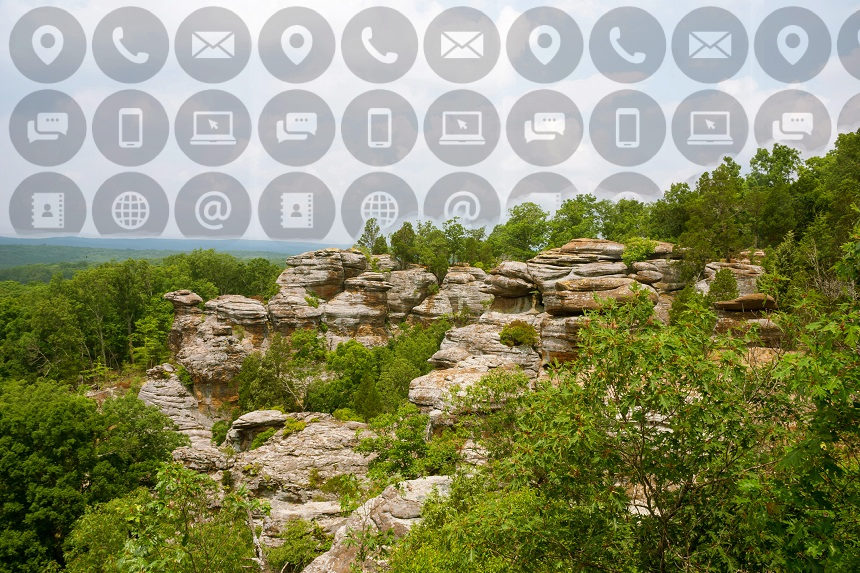On normal mornings, I wake up and immediately grasp my cell phone from its resting spot next to my pillow and Google the previous day’s new Coronavirus cases. At least, that’s how it’s been for the past few months. But when I woke up last weekend, there was no frightening uphill chart to behold, because there was no phone. I rolled over and gazed out at a blur of treetops through a tent screen. I put on my glasses and realized I was looking over a foggy valley, that the camping spot I had stumbled onto late the night before sat on a cliff perfectly situated to receive the sunrise.
When I decided that I would leave my phone behind to disappear into southern Illinois’s Shawnee National Forest for the weekend, my roommate was concerned. “Why would you do that?” she asked. “What if you get lost?” I told her that people don’t get lost in America in 2020. “That’s because they have cell phones!” she countered.
I would hesitate to claim I have smartphone addiction, but I’ve been known to pass hours slumped on the couch, scrolling through yoga videos I might one day try, bruschetta recipes I might make, far-flung destinations I might visit. I’ve lingered a little too long on Twitter during work hours (don’t tell my editor), and there was that one blur of a weekend that was entirely lost to the engrossing Bloons Tower Defense 6 game.
Of course, I’m not alone in my tendency to zone out and fall headfirst into the time-consuming trappings of the device. According to several surveys from 2017, Americans, on average, spend from three to five hours each day on mobile devices. For younger people, the number is even higher. Our collective panic over wasting time on our phones has created space for some savvy panaceas in the private sector. Tech rehabs have cropped up, self-help texts for more mindful phone use abound, and Google has even gotten in on the action with their launch of Digital Wellbeing. The app gives users a rundown of their screen time and offers nanny-style blockers from too much browsing and scrolling.
I wasn’t seeking such a formal tech break, though; I only wanted to test out the cold turkey method for a weekend. So I dug out my backpacking gear from the back of my closet, gathered a few books (Birds of America by Lorrie Moore and Dept. of Speculation by Jenny Offill), and prepared to realize some long-held plans to visit a jewel of the Midwest: the Garden of the Gods Wilderness. I told my dog Calliope where we were going, and she seemed indifferent.
My loved ones insisted that I at least keep my phone in the car. I could stash it away and keep it turned off, they said, as it could be necessary for an emergency. I was travelling four hours away to an unfamiliar area, and my Prius did have about 550,000 miles on it. I might have something to prove, I thought, but I’m not stupid. I resolved to hiding it in the trunk.
What would it be like, I wondered as I followed my handwritten directions across hilly southern Indiana, to spend a few days with only my thoughts and my dog? On a local radio station, the deejay gave a shout-out to her “Facebook friend of the week” and directed listeners to her page to check out a video she’d posted of a cute animal. I lucked out and found an Ella Fitzgerald CD in the glove box left by the previous owner.
The Shawnee National Forest, stretching across southern Illinois between the Ohio and Mississippi rivers, covers almost 300,000 acres. The sandstone cliffs, bluffs, and hoodoos of the Garden of the Gods were created more than 300 million years ago when the region sat on the north shore of an enormous sea. The continental glaciers that carved much of the state into flatlands stopped just short of the Shawnee Hills, allowing these ancient structures to remain intact and providing views unlike anywhere else in the Midwest.
There is also plenty of wildlife — both dangerous and benign — to be found in the forest. Box turtles, raccoons, opossums, hawks, vultures, and squirrels are everywhere. With some bad luck, you might stumble onto a cottonmouth, copperhead, or even one of the elusive rattlesnakes, the timber rattler or the massasauga (all the more reason to refrain from hiking-while-texting). There are black widow and brown recluse spiders as well as the velvet wasp, a wingless ant-looking bug that delivers “the most painful insect sting in the world.” Encountering any of these spine-tingling creatures is fairly rare, however, and dying from any of them is all but unheard of. That’s what I told myself as I marched through the woods in the middle of the night, my flashlight casting quick, darting shadows on the vast expanses of poison ivy.
Since Shawnee is a national forest, it’s free to camp anywhere you’d like, as long as you maintain some distance from trails and waterways. You can often find unofficial campsites where others have constructed stone fire rings and makeshift seating. On the second night, Calliope and I stumbled upon such a spot, and I built a fire to cook ramen while she collapsed nearby and stared at me thinking, what in the hell are we doing here?
What were we doing there?
I had scratched the long-disquieting itch to get away from it all, but at first it seemed I had traded isolation in my home for isolation in the woods. Camping alone, or with a furry friend, is a surefire way to strip down the distractions of daily life and spend time thinking about where you are and where you’d like to be, both literally and metaphysically. Going without a phone is akin to constant meditation, at once trapped with your own thoughts and liberated from the fast lane of the information superhighway.
There has been some research into the effects of “problematic smartphone use”— particularly as it applies to young people and social media. We know that poor emotional well-being and smartphone overuse are often connected, but causation is difficult to prove. A study released this year in Cyberpsychology looked at “FoMO” (fear of missing out) and PSU (problematic smartphone use) as two separate but connected factors affecting emotional well-being. The findings suggest that it can be a sort of a vicious cycle, with negative feelings arising from both “FoMO stimulating online relationships at the cost of offline interactions and physical symptoms associated with excessive smartphone use.”
The study, along with many others, lends credence to something many of us innately understand: when I waste too much time on my phone I feel bad afterwards, and when I feel bad, I retreat to the comfortable, familiar habit of slingshotting angry birds and scrolling through my ex’s gym selfies.
Without a phone, I noticed more of the world going on around me, like the yellow butterfly that landed squarely on my dog’s nose and stayed, flexing its wings, until she shook it off. I noticed the complete silence that overtakes the woods at dusk. It comes right after the birds’ chirping has tapered off and right before the crickets and katydids begin their nighttime cacophony of sounds. I sat and listened, feeling still alone but also incredibly peaceful — the kind of feeling I might be able to define perfectly by whipping out my phone and Googling an antonym for “stress.” The forest offers this to anyone willing to turn off and tune in to the natural world.
Could there be a way to experience this kind of quiet and focus without hiking for hours and pumping creek water through a charcoal filter?
On Sunday, I slept in to some unknowable hour and then packed up my things, planning to make the trek straight back to the car and drive immediately to the nearest store for a sugary canned coffee drink. Calliope and I set off, making our way through the trails we had hiked in on. When we came to a familiar four-way intersection, I consulted the map and continued on a trail that, I was 90 percent certain, would take us back to the car.
After an hour of hiking deeper and deeper into the woods, I realized we were on the wrong trail. It curved around in a disorienting fashion, and led to a steep uphill climb that I distinctly did not recall from the hike in. Then we found ourselves climbing uphill even more, and yet again. Turning around the bend of every curve brought the excruciating sight of more ascending trail. How high could we possibly be going? I thought. It’s Illinois!
Then, we turned a new corner to find a clearing. Approaching it, I saw that it overlooked the valley in which I’d spent the past few days camping. It had to be the highest point in the park, with a view of the forest and even the farmland past it for miles. The dog walked right up to the edge and looked over, and I realized that I hadn’t known for years whether she was afraid of heights because I hadn’t taken her to any cliffs before. She stood proudly before her domain, creating the perfect opportunity for an adorable (hypothetical) Instagram picture. There would be no evidence on social media of the trip: no livetweeting, no 360-degree videos, no deluge of Facebook likes from jealous friends. The whole thing would have to be archived in my own mind.
When we finally found our way back, we were practically crawling to the doors of the Prius. Driving home, I reflected on the merits of “unplugging,” and what exactly the big takeaway could be from such a short vacation from tech. Would I arrive home and immediately revert to my old ways of binge-reading Twitter drama and feeling phantom phone vibrations on my left thigh every 10 minutes? Would I even remember this vacation if I couldn’t be reminded of the beauty of the Garden of the Gods by Facebook Memories in years to come?
What I will remember is the noticeably heightened sense of focus and peace I felt in the woods. If you give up the smartphone for a few days, you might become hyper aware of just how long it has been since you lived without one. But realizing that it is possible can inspire you to take more breaks from your smartphone day to day. Leave it at home and go on a long walk, or pledge to trim down your notifications. You might be surprised by how much you notice when you aren’t always grasping for your phone. And we could all use more pleasant surprises.
Featured image: Shutterstock, by Oleksandr Koretskyi and A-spring
Become a Saturday Evening Post member and enjoy unlimited access. Subscribe now




Comments
First of all, I’m glad you got through your weekend voyage of discovery safely. No snakes or poison ivy! To me the worst part sounds like it was going deeper into the woods then realizing you were on the wrong trail. It can be very disorienting and confusing. An uphill battle that went further and further up before reaching the top. It seems like it was worth it as the scene you describe sounds magnificent. The trip back had to be easier, but I can see how you’d be exhausted.
I believe the trip was worth it, and having your dog along made all the difference. Just seeing that yellow butterfly landing and staying on her nose and seeing her shake it off. You’ll never forget that. The peaceful easy feelings you describe being ‘one with nature’ are wonderful. Being without your phone allowed you to experience this.
Like increasing your endurance and strength by exercising, increasing the time you decrease interacting with the phone releases you from being a prisoner of your own device, and becoming a liberated man. Yes, you’ll check it, but now know you’re not ‘missing out’ on anything. What’s BEEN MISSING has been the connection with nature and the healing tranquility that goes with it.
In addition, you realize how important sleep is, and if you get enough you don’t need unhealthy amounts of caffeine from money-sucking Starbucks or the potentially deadly Monster/Throttle. Real life is throttling enough now as it is. All the more reason to experience the pleasant surprises of going for long walks (and periods of time) without the phone.